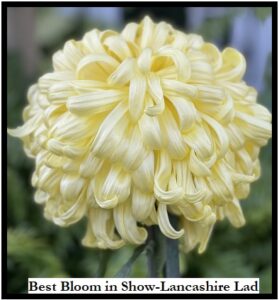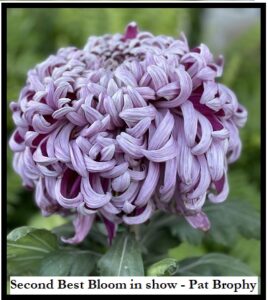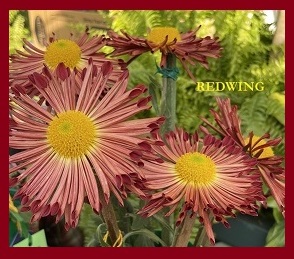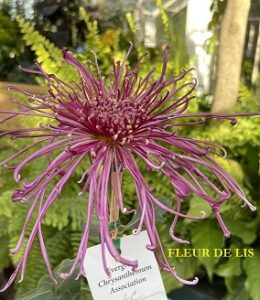EVERGREEN CHRYSANTHEMUM ASSOCIATION
Seattle, Washington
ECAmumclub.org
Jim Anshutz,Secretary
MEETING OF THE ECA – THURSDAY September 8th, 2011 at 7 PM at the Seattle Police Athletic Association Office (SPAA) site at 11030 East Marginal Way South, Tukwila.
ANNUAL GARDEN TOUR – The annual garden tour and picnic was Sunday August 14th.
Kubota Gardens was spectacular: a must see!! Great coffee and fellowship at Mary Lou & Bob Ewings and a tour of the gardens at Wesley Terrace. We finished up with an awesome picnic @ Janet & Mark Ross’ home. Great Food & fun.
SEPTEMBER MEETING: This is a very important meeting as we begin to prepare for our annual show October 29 and 30st with set up on October 28. The annual show will be held again at Furney’s Nursery, 21215 International, Blvd. and Pacific Hwy. S.
We will also discuss our exhibit and staffing for our club booth at the Aki Matsuri festival. The Aki Matsuri (Fall Festival) will be held September 10th and 11th at Bellevue College. For those of you with flowers or plants that we can display, please bring them to the September 8 meeting. We will be setting up our exhibit on Friday, September 9 so please also bring the club membership and notice of plant sale cards, the picture boards and a few vases for displaying flowers to the Thursday, September 8 meeting so they can be taken to set up at Bellevue College. We will also be calling Don, Mark, Mike Kubo, Bob and others to remind them to bring these items to our September 8 meeting.)
We need volunteers to take 2-3 hour shifts at our Aki Matusi table on Saturday and Sunday. This year’s schedule is Saturday, September 10 from 10am – 6 pm and Sunday, September 11 from 10-4:30. There will be a sign up sheet at the September meeting or email me with your willingness to help staff our booth.
Thanks to LAST YEAR’S VOLUNTEER Ron Elliott for agreeing to do the take down and to those members who have flowers/plants to show.
Directions to BCC (take 148th Ave SE Exit from I-90, get in left lane on 148th SE and turn into Bellevue College ) and a map of the Campus are available at the BCC website.
(Look for building G)
Again, for those who already have mature blooms, consider displaying them at Aki Matusi or entering them in the Puyallup Fair.
For information about the Puyallup Fair, go to HYPERLINK http://www.thefair.comwww.thefair.com on the internet. This year’s Chrysanthemum show is on September 24.
.PLANT CULTURE and SUPPLIES: – The September meeting will devote time to the care and feeding of the blooms as they develop; Club supplies will be available, place orders for specific items with Mark Ross. Cultural recommendations are attached. With possible rain or showers consider your sheltering options for September as we move to the latter part of the growing season.
SAVING PLANTS FROM DAMAGING FREEZING WEATHER
Chris Brooks wanted to share some information that could be of great assistance to members in over-wintering plants. As Chris noted many members loose plant stock during the winter because they keep everything in unheated greenhouses and sheds. None of us want to heat such poorly insulated spaces but would like to have a way of putting on that little bit of heat for a short while when temperatures approach 32 degrees F. Heaters that go as low are simply not available. Don Stark has solved the problem by plugging a heater into a portable waterproof thermostat which can be set to turn on and off anywhere above 30 degrees F. Such thermostats are not easy to find and are not cheap—often more than $75 around here. Chris found a good source out of state at Farmteck 1-800-327-6835. They sell such thermostats for $49.95. Chris states they stock about everything you would want for a farm or garden and suggests it would be pay to combine orders since their minimum shipping charges are $13. Chris suggests we discuss this at a future meeting.
SEPTEMBER TO DO LIST – (adapted from Don Stark 9/98 notes)
Once the buds have broken the membrane and some petal tips are showing, it is time to get the pots into or under some kind of shelter. The basic idea is to protect the blooms from rain and dew. If rain or dew is present when the sun strikes, you will almost certainly burn the florets. Shelters come in a variety of sizes, names, and shapes including porches, large overhanging eaves, garages, greenhouses, and temporary wood and plastic structures.
Sheltering Plants During the Bloom Cycle Starting September 1
Shelter requirements are daytime light (though it can be shady), ventilation, and temperature control.
Maximum temperature should be kept below 80 degrees F if possible. Above that temperature the probability of bloom damage due to petal rot is high. If the shelter is exposed to too much sun in the early Sept days, the temperature within the shelter can skyrocket.
Big fans keep the air moving and the temperature down. Fans also hopefully can bring air from a shady side of the shelter to cool the overall area as well.
Lining the inside of the shelter with old sheets or muslin will also reduce the heat and filter the sunlight.
Bring Pots Into Cover
Wash the pots to get rid of the crud and residue from the growing area.
Pick off old dead and damaged leaves (mostly at the bottom of the plant) that harbor pests and fungus.
Spray the plant with a fungicide and insecticide before taking to the shelter.
Watch for and destroy earwigs. They wreck blooms when they get inside.
Top-dress the pots again. Put about ½ to ¾” of the 9-Inch mix or Soilless mix on the surface of the pot and level it. Top-dressing the plants helps finish plant growth now and also promotes shoots on the plant stools for our next growing season.
Optionally, add ¼ teaspoon FeSo4 to enhance color. Do not add to plants with white or yellow blooms.
Add ¼ teaspoon of Potash to help harden off the plant and keep the blooms from being too soft.
Plant Clean Up and Cut Back to Final Lateral Count
As the plant goes to shelter, if not already done, cut back to the final lateral count selecting the best overall laterals. For #1’s keep 1 or 2 blooms per plant, #2’s keep 2 blooms per plant, #3’s and others excluding specimen plants keep 2 to 5 blooms per plant.
Stake and tie up the selected laterals and add support shingles for the blooms as you house the plant.
Remove or pick off the side laterals on the selected stems.
Fertilizing & Watering
For late season fertilizing, reduce fertilizer to ½ strength for 2-3 weeks. After the petals start to fall, gradually increase feed. Switch to a higher potash fertilizer along the lines of a 15-10-30 or other bloom feeder fertilizer and go lightly.
Watering is different at this stage as the plants are kept a little dryer at this stage. Water plants more sparingly, using about 1 pint per watering. Do not water when the temperature exceeds 75F.
There are two schools of thought as to the best time of day to water. Previous year cultural notes recommend to water in the evening as the day is cooling down to help avoid sending the plant sap to the blooms in heat of day and blowing out or cracking the bloom neck. Bob Walker recommends watering in the early part of the day.
Water/fertilize from a bucket using a 1-pint jar or similar small container. Do not use the hose and spread water everywhere on the shelter floor. Keep the finishing area dry and clean.




